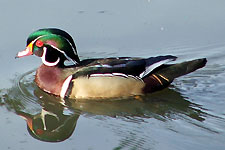Local Wildlife
Wood Duck

Scientific Name: Aix sponsa
Audio: Listen Now
Audio Source: U.S. Geological Survey
Addt'l Info: Univ. of Michigan
The male wood duck has, perhaps, the most distinctive markings of any duck on earth. Its green head, red eyes, and black-and-white markings make it hard to miss. Rust-colored chests, bronze sides, and black backs and tails complete the look. The inner part of the forewings is light blue and the underside is white. The female has a light brown head and neck, gray bill, and brown eyes. Both have mottled brown wing feathers.
Wood ducks can be found in various habitats where water is present or near. This includes vegetated wetlands as well as ponds, creeks, rivers, or small lakes and the wooded areas that surround or run alongside them. Wood ducks are one of only a few ducks in North America that nest in trees. Cavities in dead trees located near water are favorite nesting spots and nests are generally lined with feathers and wood chips. In Sunriver, you are most likely to see wood ducks paddling in the stagnant inlets of the Deschutes river or the waterways that connect Lake Aspen to it.
As omnivores, wood ducks eat a wide variety of insects and plant material. Primary food sources include nuts, seeds, beetles, moths, flies, wasps, bees, slugs, ants, butterflies, sowbugs, and snails. Adults use a range of calls to warn of danger, attract a mate, locate a mate, and call ducklings. Wood ducks are diurnal (active in the morning and evening) and quite social, often congregating together in the evening.
Wood ducks mate mid-March to mid-April, resulting in six to fifteen eggs (though some females will lay their eggs in another's nest, boosting that number significantly). Eggs are incubated for around a month at which time the chicks hatch and then leave the nest a day later. Once out of the nest, ducklings become independent from their mother after 56 to 70 days.
